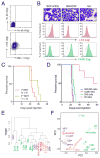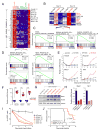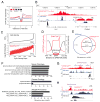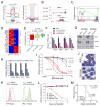Epigenetic Perturbations by Arg882-Mutated DNMT3A Potentiate Aberrant Stem Cell Gene-Expression Program and Acute Leukemia Development
- PMID: 27344947
- PMCID: PMC4945461
- DOI: 10.1016/j.ccell.2016.05.008
Epigenetic Perturbations by Arg882-Mutated DNMT3A Potentiate Aberrant Stem Cell Gene-Expression Program and Acute Leukemia Development
Abstract
DNA methyltransferase 3A (DNMT3A) is frequently mutated in hematological cancers; however, the underlying oncogenic mechanism remains elusive. Here, we report that the DNMT3A mutational hotspot at Arg882 (DNMT3A(R882H)) cooperates with NRAS mutation to transform hematopoietic stem/progenitor cells and induce acute leukemia development. Mechanistically, DNMT3A(R882H) directly binds to and potentiates transactivation of stemness genes critical for leukemogenicity including Meis1, Mn1, and Hoxa gene cluster. DNMT3A(R882H) induces focal epigenetic alterations, including CpG hypomethylation and concurrent gain of active histone modifications, at cis-regulatory elements such as enhancers to facilitate gene transcription. CRISPR/Cas9-mediated ablation of a putative Meis1 enhancer carrying DNMT3A(R882H)-induced DNA hypomethylation impairs Meis1 expression. Importantly, DNMT3A(R882H)-induced gene-expression programs can be repressed through Dot1l inhibition, providing an attractive therapeutic strategy for DNMT3A-mutated leukemias.
Copyright © 2016 Elsevier Inc. All rights reserved.
Figures







Comment in
-
Modeling the Epigenetic Chain Reaction Downstream of DNMT3A(R882H).Cancer Cell. 2016 Jul 11;30(1):9-10. doi: 10.1016/j.ccell.2016.06.018. Cancer Cell. 2016. PMID: 27411582
Similar articles
-
Genetic and Epigenetic Perturbations by DNMT3A-R882 Mutants Impaired Apoptosis through Augmentation of PRDX2 in Myeloid Leukemia Cells.Neoplasia. 2018 Nov;20(11):1106-1120. doi: 10.1016/j.neo.2018.08.013. Epub 2018 Sep 21. Neoplasia. 2018. PMID: 30245403 Free PMC article.
-
DNMT3A mutations mediate the epigenetic reactivation of the leukemogenic factor MEIS1 in acute myeloid leukemia.Oncogene. 2016 Jun 9;35(23):3079-82. doi: 10.1038/onc.2015.359. Epub 2015 Oct 5. Oncogene. 2016. PMID: 26434589 Free PMC article.
-
Novel impact of the DNMT3A R882H mutation on GSH metabolism in a K562 cell model established by TALENs.Oncotarget. 2017 May 2;8(18):30395-30409. doi: 10.18632/oncotarget.16449. Oncotarget. 2017. PMID: 28418922 Free PMC article.
-
DNMT3A in Leukemia.Cold Spring Harb Perspect Med. 2017 Feb 1;7(2):a030320. doi: 10.1101/cshperspect.a030320. Cold Spring Harb Perspect Med. 2017. PMID: 28003281 Free PMC article. Review.
-
[Functional role of DNMT3A mutation in acute myeloid leukemia].Rinsho Ketsueki. 2018;59(5):602-610. doi: 10.11406/rinketsu.59.602. Rinsho Ketsueki. 2018. PMID: 29877252 Review. Japanese.
Cited by
-
Hemophagocytic lymphohistiocytosis and myelodysplastic syndrome: a case report and review of the literature.J Med Case Rep. 2021 Mar 1;15(1):98. doi: 10.1186/s13256-020-02623-2. J Med Case Rep. 2021. PMID: 33648567 Free PMC article. Review.
-
Aberrant DNA Methylation in Acute Myeloid Leukemia and Its Clinical Implications.Int J Mol Sci. 2019 Sep 16;20(18):4576. doi: 10.3390/ijms20184576. Int J Mol Sci. 2019. PMID: 31527484 Free PMC article. Review.
-
Epigenetic Erosion in Adult Stem Cells: Drivers and Passengers of Aging.Cells. 2018 Nov 29;7(12):237. doi: 10.3390/cells7120237. Cells. 2018. PMID: 30501028 Free PMC article. Review.
-
Mouse Models of Frequently Mutated Genes in Acute Myeloid Leukemia.Cancers (Basel). 2021 Dec 8;13(24):6192. doi: 10.3390/cancers13246192. Cancers (Basel). 2021. PMID: 34944812 Free PMC article. Review.
-
DNA methyltransferase-1 in acute myeloid leukaemia: beyond the maintenance of DNA methylation.Ann Med. 2022 Dec;54(1):2011-2023. doi: 10.1080/07853890.2022.2099578. Ann Med. 2022. PMID: 35838271 Free PMC article. Review.
References
-
- Abramovich C, Pineault N, Ohta H, Humphries RK. Hox genes: from leukemia to hematopoietic stem cell expansion. Annals of the New York Academy of Sciences. 2005;1044:109–116. - PubMed
-
- Argiropoulos B, Humphries RK. Hox genes in hematopoiesis and leukemogenesis. Oncogene. 2007;26:6766–6776. - PubMed
-
- Baubec T, Schubeler D. Genomic patterns and context specific interpretation of DNA methylation. Current opinion in genetics & development. 2014;25:85–92. - PubMed
-
- Campisi J, d’Adda di Fagagna F. Cellular senescence: when bad things happen to good cells. Nat Rev Mol Cell Biol. 2007;8:729–740. - PubMed
Publication types
MeSH terms
Substances
Grants and funding
LinkOut - more resources
Full Text Sources
Other Literature Sources
Medical
Molecular Biology Databases
Miscellaneous

